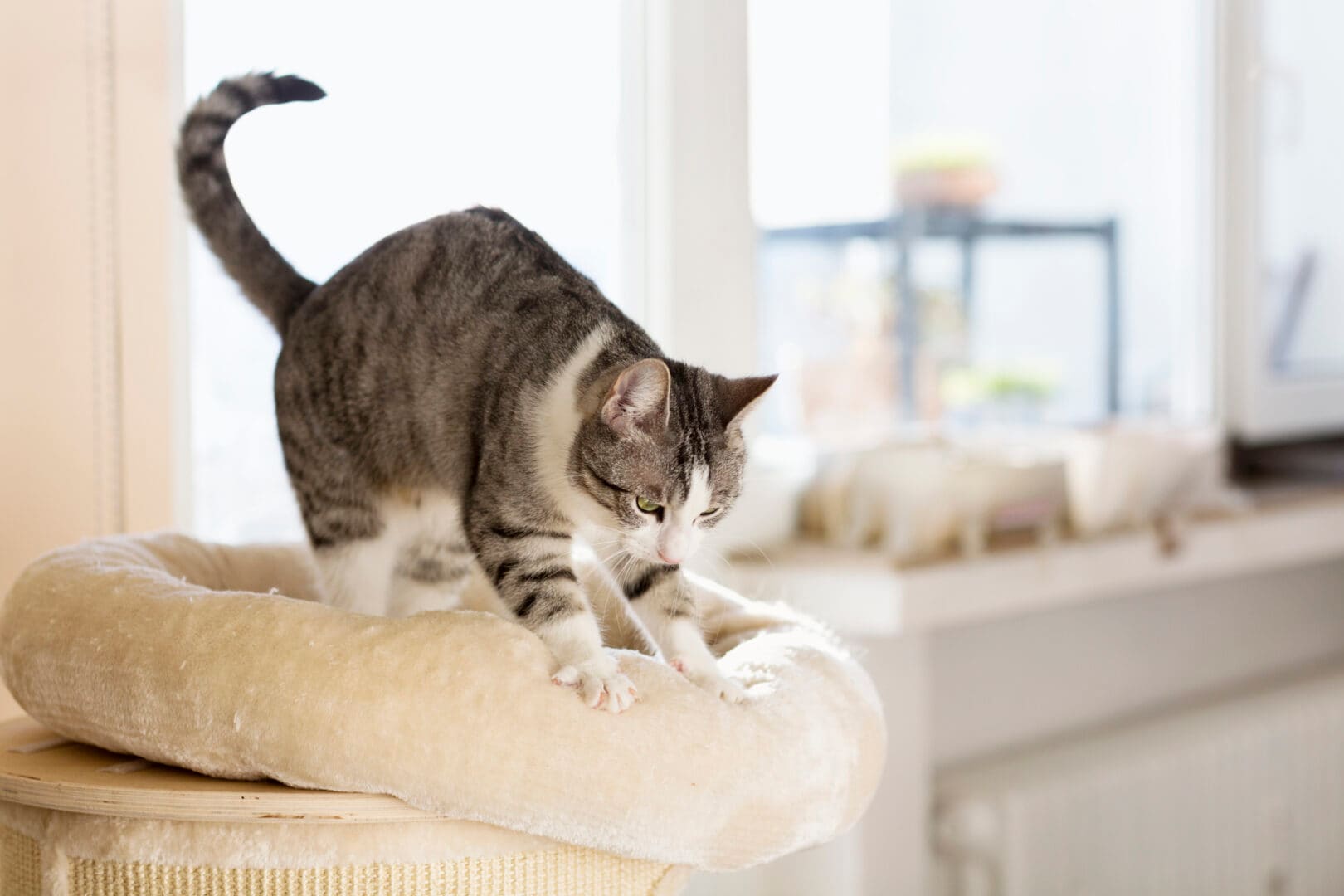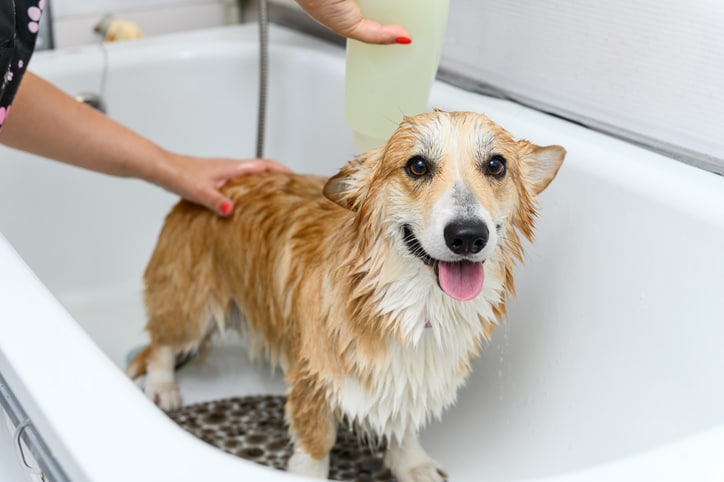Have you ever watched — or felt — your cat press their front paws against a soft surface then rhythmically extend and contract their tiny toes? If so, you are familiar with every cat’s innate ability to make biscuits, otherwise known as kneading.
“Cats knead on things to help them communicate,” explains Jennifer Feeney, a doctor of veterinary medicine and pet behaviorist. “There are many cute phrases for this behavior that most cat owners adore, including making biscuits, mashing potatoes or muffin making because the motion they make is similar to how a human kneads dough.”
Like cat love bites and cat zoomies, cat kneading is a healthy feline behavior, yet it can be a little confusing — especially if your cat chooses you as their favorite place to knead. Here, experts explain why cats knead and what it means when your cat makes biscuits.
What is cat kneading?
“Kneading is part of normal nursing behavior in kittens that stimulates milk production,” explains Leanne Lilly, a doctor of veterinary medicine and assistant clinical professor at the Ohio State University Veterinary Medical Center. Kneading might also release mammary pheromones, or soothing scents that come from their mother’s teat, which keep kittens calm, she explains.
So why do older cats knead even after they’re done nursing? “When adult cats knead, it’s because of something called neoteny, which is when an animal retains juvenile behaviors into adulthood,” Feeney says. “Because the experience of nursing is pleasurable to cats, kneading is associated with pleasurable emotions, and many cats continue to do it for their entire lives.”
Most cats knead several times a day, for several minutes at a time. But some adult cats don’t knead at all, Feeney notes, which is also normal and healthy.
“Because the experience of nursing is pleasurable to cats, kneading is associated with pleasurable emotions, and many cats continue to do it for their entire lives.”
—Jennifer Feeney, a doctor of veterinary medicine and pet behaviorist
Why do cats make biscuits?
“Thought to be instinctual, cats knead to comfort, soothe or calm themselves,” explains Rochelle Guardado, certified cat behavior counselor and animal training manager at Pasadena Humane.
Depending on your cat’s temperament and environment, though, they can have different motivations for making a warm batch of calming cat biscuits. Here are the most common reasons why cats knead, according to the experts we spoke to.
Cats knead when they’re comfortable
In general, kneading means that your cat is comfortable or is in the process of getting comfy, Lilly explains. According to our experts, cats usually seek out warm, soft surfaces to knead when they feel calm — which can include a cozy chair, their favorite person’s lap or even on other cuddly pets in the household. Some cats may even be motivated to knead by the texture or scent of a certain material they like, Feeney adds. “Other cats just knead on whatever is nearest to them when they’re feeling happy,” she says.
Cats knead to calm anxiety or stress
Cats seeking comfort rather than already feeling comfortable may knead as a method of self-soothing, notes Lilly. One way to know if your cat is kneading to soothe anxiety is by taking note of the frequency and length of their biscuit-making sessions.
“Depending on their daily routine and environment, it is common for cats to knead for anywhere between several seconds to a few minutes at a time,” Guardado says. “But if your cat is seeking to calm themselves due to stress or anxiety, the kneading may take place more frequently or for longer periods of time.”
If your cat’s amount of kneading habits increase or decrease, or your cat is kneading to the exclusion of other behaviors like lounging, playing, grooming, sleeping or eating, you should consult with your veterinarian, Lilly says.
Cats make biscuits to get ready for bed — or another nap
“All felines tend to knead on things as part of resting place preparation,” Lilly says. “Soft resting places such as blankets, couches and humans are common ‘targets.’” Pre-nap cat kneading is just like dogs who circle several times before laying down to manage a resting place much like dogs scratching and turning to nest, she adds. And since it’s normal for cats to sleep 15 hours a day, it’s really no wonder why cat owners are so familiar with the feline art of biscuit making!
Cats knead to spread their scent
Cats may also knead to leave their scent in the area, similar to when they rub their cheeks on objects to mark them. Leaving behind scent marks is part of a cat’s territorial management, or how cats claim a certain area as their own, according to Lilly. Along with kneading, felines have a variety of ways to do this, including scratching and urine marking.
Like their cheeks, a cat’s front paws have scent glands, or glands that contain pheromones which are unique to that cat, explains Guardado. “[Spreading] these scent glands are an important way for the cat to feel comfortable and confident in their environment,” Guardado says. “Every cat in the house should have spaces where they can leave their own scent as well as spaces where they can mix their scent with the other people and pets in the home.”
Why do cats knead on you?
“Cats who feel a special bond with their caretakers often look to their laps for comfort,” Guardado says. “Whether it’s to soothe themselves after a stressful appointment at the veterinarian’s office or just enjoying your warm pajamas on a cold night, cats share their affection and trust when they knead on you.”
When your cat is kneading on you, it can also have a territorial motivation, Feeney explains. “Scent is incredibly important for cats, especially for cats in the same social circle — meaning that they live together in the same area, such as a multiple cat household,” she says. “When your cat kneads on you, he’s telling everyone else in the household, ‘You’re mine.’”
So what should you do if your cat likes to make biscuits on you? “Purring and kneading is one way that your cat is telling you she loves you,” Feeney says. “There’s no reason to stop [kneading] behavior if you are both enjoying your time together. It is often a beloved and bonding activity for cat owners and their cats.”
Why do cats knead then bite?
“Most of the time, kneading is a very relaxing and comforting activity for your cat,” Feeney says. It can be so relaxing, in fact, that it can be coupled with drooling or even cat love bites, which can be brought on in moments when cats feel a strong sense of bonding. “Sometimes, the kneading will be accompanied by little ‘love nips’ where they will grab whatever body part is nearby and hold it gently in their teeth which is very normal,” she explains.
Instinct may also be coming into play if your cat kneads then bites. “We also need to remember that kneading used to be part of the nursing reflex — thus eating reflex — and cats eat with their mouths,” Lilly says. “So there may be a tendency for the behaviors to spill over into each other because of their prior connection.”
However, it’s important to remember that love bites are playful, and they do not break the skin, according to experts. If your cat is biting harder while kneading, these are more likely causes:
- Your cat is overstimulated. “If a cat is kneading to try to soothe anxiety, sometimes added stimulation like petting can override their ability to self-settle which can lead to biting harder,” Lilly explains.
- Your cat wants to be left alone. “Some cats prefer not to be touched when they are trying to relax in this manner,” Guardado says. “If they are handled in a way that they dislike [while kneading], it can lead to a bite.”
- Your cat is getting distracted. If cats are prevented from carrying out their kneading, they can become frustrated which may lead to mouthing or biting, Guardado explains.
- Your cat is overly anxious. Some cats may bite harder during kneading as a sign that they are stressed or in pain, Feeney says. She advises visiting your veterinarian if you notice your cat kneading too frequently or for long periods as well as biting.
“Letting your kitty carry out this important behavior is essential to their well-being.”
—Rochelle Guardado, certified cat behavior counselor
What should you do when a cat kneads?
“In general, keep doing what you are doing when a cat is kneading,” Lilly says. In fact, if a cat is disrupted from kneading due to the caregiver’s displeasure, it may lead to frustration which can cause unwanted behavior issues, Guardado adds.
However, if your cat’s biscuit making has started to include unwanted behavior, or they are at risk of hurting someone or something with their claws, experts recommend that cat owners step in. Here are their best tips for keeping cat kneading under control:
Keep your cats nails trimmed
When cats are making biscuits, they often grip with their toes, but they typically do not extend their nails, Lilly explains. However, it’s still a good idea to keep their nails trimmed to protect soft surfaces, especially if they like to knead on your skin as it can be painful if their nails are sharp. If you’re experiencing any discomfort from your cat’s kneading behavior, you can also try placing a thick blanket between their paws and your skin
Customize a space specifically for making cat biscuits
If your cat’s kneading is causing damage to an item such as a piece of furniture or bedding, putting a blanket over the area to protect or redirecting them to a whole new location can help, Guardaro explains. “If you do not want your cat to knead on something that may get damaged, find a suitable item that your cat finds equally pleasurable,” Guardaro says. “A heating pad made especially for pets is a great choice to offer your kitty a safe place to knead and rest.”
Reward your cat for kneading in a new safe spot
If you’re trying to redirect a cat to knead somewhere else, Lilly recommends rewarding them for doing so with praise, petting or even a treat. “Remember that [kneading] is a normal cat activity, just like sleeping and eating, and we should not expect a cat to fully stop doing it even if they are doing it in a way that is not ideal for us humans,” Lilly says.
Speak with your vet if you notice aggression
Some cats get overly aroused during kneading, especially if you’re petting them, Feeney warns. “That arousal can turn into aggressive play or even just aggression, depending on your cat,” she says. If this happens, she advises cat owners to speak to their veterinarian or a cat trainer to learn how to stop this behavior.
Ultimately, kneading is a healthy way cats signal that they are comfortable, getting ready to nap or would like to feel more relaxed in their environment. The bottom line, according to Guardardo: “Letting your kitty carry out this important behavior is essential to their well-being.”

